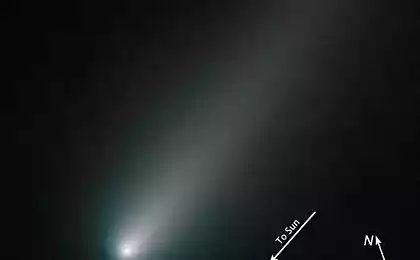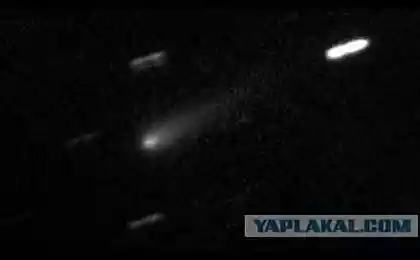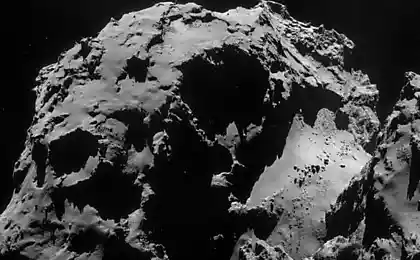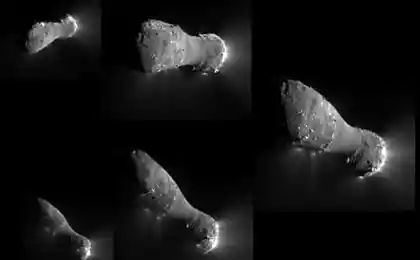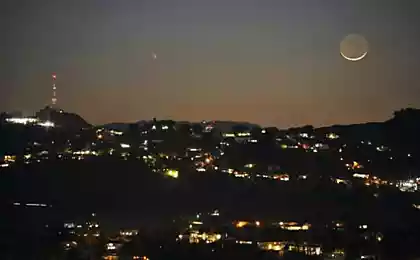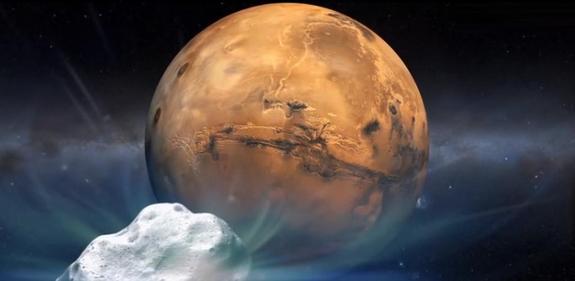
The artist depicted the comet Siding Spring (2013 A1) rushing to Mars.
Closest approach will occur October 19, 2014.
Photo: NASA. Полный size
Sup> blockquote> Comet closer to Mars, the minimum distance, next weekend. In connection with that NASA prepared for this dramatic cosmic events.
The space agency has already produced a number of research equipment for the Comet Siding Spring (Siding Spring), which is closer to a distance of 87,000 miles (139,500 kilometers) of Mars on October 19 - or approximately 1/3 of the distance from the Earth to the Moon. In this connection, located at the NASA fleet of the Red Planet, and consists of satellites and rovers will be watching this momentous day, study the comet and its impact on the atmosphere of Mars.
"October 19, we will observe an event that happens once in a million years," said at a conference today (October 9), Jim Green (Jim Green), Head of NASA's study of the planets. "We are preparing for an impressive number of observations." [ Here you can see a photo of a comet ]
The first observation h4> Comet Siding Spring, also known as C / 2013 A1, was opened in 2013 by astronomer dunk Rob (Rob McNaught) in Australian Siding Spring Observatory. Comet committed his first trip through the solar system from a cold and distant Oort Cloud, which is located, approximately 50,000 astronomical units from the Sun (One astronomical unit [AU] - this is the average distance between the Earth and the Sun - about 150 million kilometers.)
Researchers say that because of the fact that the comet before that never heated, it remained unchanged since the formation of 4, 6 billion years ago. Thus the study of its structure and behavior give evidence about conditions that existed at the time of formation of the solar system.
"It's one of the reasons for which we are studying comets - they are fragments of time of formation of our solar system," said Padma Yanamandra-Fisher (Padma Yanamandra-Fisher), a senior fellow of the California branch of the Space Research Institute of Rancho Cucamonga.
Observations of a number of missions, including the Hubble, Swift, Spitzer and NASA spacecraft Neowise, have already provided some data on the Siding Spring. For example, the researchers believe that the comet nucleus is from 0, 5 to 5 miles (0, 8 to 8 km) in diameter. Furthermore, this dust cloud point (or кома), surrounding the nucleus Siding Spring particles is about 100,000 miles (160 000 km) wide, and its tail stretches for 300,000 miles (480 000 km), scientists say.
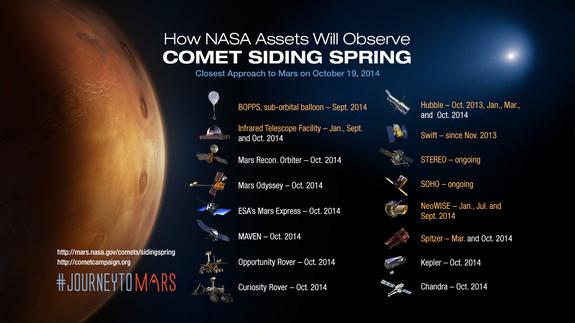
Extensive research fleet will observe the comet Siding Spring before and after it is closer to Mars 19 October 2014.
Photo: NASA, Полный size
Sup>
Blockquote> But the real show starts on October 19. Three orbiters NASA - Mars Odyssey, Mars Reconnaissance Orbiter (MRO), and newcomer, spacecraft MAVEN - will observe span Siding Springs from space, while the rovers Opportunity and Curiosity will observe from the surface of the Red Planet.
Researchers say that the purpose of observation to know the dimensions, the speed and the composition of the comet. The interaction between the particles of the comet and the atmosphere of Mars, will also help scientists to better explore the very atmosphere of the Red Planet. MAVEN is particularly well suited for the latter problem, because his mission is to study the upper atmosphere of Mars (MAVEN is short for Mars Atmosphere and Volatile Evolution).
If everything goes according to plan, the MRO will receive the first good picture of the nucleus of the comet from the Oort cloud. Perhaps Opportunity and Curiosity can contribute, if dust storms do not stir up too much atmosphere.
"We certainly cross our fingers for the first images of the comet from the surface of another world," said Kelly Fast (Kelly Fast), NASA scientist program for the study of the planets - "It will be very interesting».
Various tools and devices will be watching Siding Spring after the flight, and will monitor the comet as the distance it into space.
Protecting spacecraft h4> Siding Spring will fly past Mars at a speed of about 126 000 miles / h (203 000 km / h) October 19. The speed is so great that even the smallest particles can seriously damage the orbiters. In this regard, NASA makes every effort that would take cell phones with a dangerous path away from sin.
"When Mars captures dust tail, it will be about 100 minutes after closest approach, all of our vehicles will be on the opposite side of the planet," said Green. "So the planet will provide additional protection, and therefore, we believe that the observations will be held in security».
Curiosity and Opportunity in safety, the researchers reported. Despite the fact that the density of the atmosphere of Mars is only 1% of the density of Earth's atmosphere, it is enough to protect the rovers from the arriving particles of the comet.
UPD1: Add link to video 2:
Video 1
Видео 2
UPD2: from the comments - maxsite : Fresh Photo of Comet near clusters M6. C of the Earth, of course. I>
Source: habrahabr.ru/post/239941/





